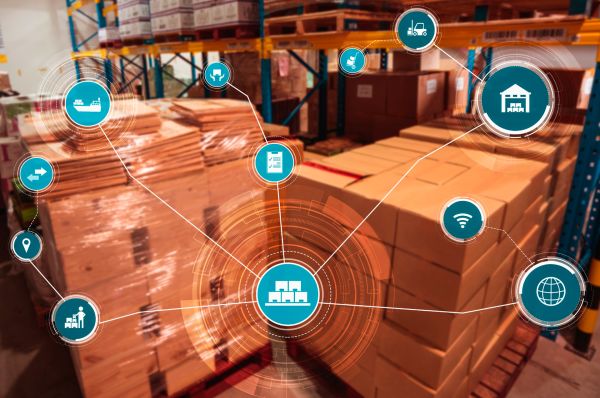
Distribution isn’t just about boxes on shelves or barcodes on products. Behind every smooth delivery and stocked shelf is a sophisticated engine: Distribution Management Software (DMS). Far beyond inventory tracking, DMS connects every moving part—orders, inventory, logistics, customers—into one seamless system. It’s quietly revolutionizing how goods move from factory floors to front doors, keeping modern supply chains agile, efficient, and always on time.
Key Takeaways:
- Distribution Management Software (DMS) is the digital backbone of logistics, far more than just inventory tracking.
- Modern DMS platforms centralize and automate every step, from order processing to last-mile delivery.
- Cloud-based, AI-driven, and integrated with ERPs, today’s DMS tools drive cost savings, accuracy, and visibility.
- Real-time data, predictive analytics, and IoT connectivity make logistics smarter and more responsive.
- Businesses using DMS report up to 25% lower costs and 30% better order accuracy.
Introduction: The Unsung Hero of Your Supply Chain
Ever wonder how that online order gets to your doorstep so fast? Or why your favorite cereal is always stocked? There’s a silent orchestrator at play, a secret weapon behind the scenes: Distribution Management Software.
But what is this software, really? It’s far more than a simple inventory tracker. Think of it as the central nervous system of a brand’s entire distribution network. A complex, interwoven tapestry of algorithms and data flows, it’s the system that streamlines, automates, and manages the journey of a product—from the factory floor to the customer’s front door.
Why does it matter, you ask? Without this level of coordination, chaos reigns. Efficiency collapses. Costly errors creep in. This technology ensures smooth operations and shields margins from logistical waste. Without it, businesses risk drowning in inefficiencies and missed opportunities.
And who’s using it? Manufacturers, wholesale distributors, retailers—anyone who needs to move goods from Point A to Point B (and sometimes C, D, and E) with high precision. It’s the lifeblood of modern commerce, quietly powering global logistics.
A Walk Through Time: The Evolution of Distribution
To truly appreciate the marvel of modern distribution platforms, let’s take a brief journey through time.
Efficient distribution has ancient roots. The Egyptians managed granaries with remarkable precision. Though lacking tech, the principles of storing and transporting goods with purpose were already in play.
During the Industrial Revolution, railroads transformed how goods moved. Primitive “distribution centers” popped up near train lines, laying the groundwork for future hubs. The telegraph improved coordination, allowing businesses to better manage stock and supply lines.
By the mid-20th century, innovations like the pallet and forklift revolutionized warehousing. Companies like UPS rose to prominence, setting the gold standard for parcel delivery. The computer age followed, bringing IBM’s early inventory systems, the first UPC barcode (1974), and J.C. Penney’s real-time Warehouse Management System (1975).
In the ’80s and ’90s, personal computing and spreadsheets laid the groundwork for Supply Chain Management as a formal discipline. With globalization and the internet, distribution grew complex, giving rise to fully integrated ERP systems.
Cloud computing took over in the 2000s, breaking down silos and enabling anytime-anywhere access. The emergence of web-based inventory tools in 2006 ushered in an era of speed, agility, and real-time visibility.
DMS Today: Your Business's Digital Backbone
Today’s distribution software is the digital nerve center of modern commerce. But what does it actually do?
- Order Coordination: From processing online purchases to tracking vendor quotes, these platforms act as mission control for order fulfillment—keeping everything moving in sync.
- Inventory Oversight: Real-time stock updates prevent dreaded out-of-stock events and costly overstocks. Many systems even use AI to forecast demand and optimize inventory levels.
- Sales and Finance Visibility: Integrated tools provide insights into sales trends, expense tracking, and automated invoicing—helping companies make smarter decisions.
- Logistics Command Center: These systems plot optimal shipping routes, manage carrier handoffs, and offer GPS tracking, ensuring every delivery is on time and traceable.
- Customer and Workflow Automation: Routine tasks like compliance reporting, customer updates, and partner communication are automated, saving time and boosting consistency.
- Data-Driven Intelligence: Custom dashboards and reporting tools translate raw data into actionable insights, helping teams operate based on evidence—not gut instinct.
Why can’t businesses function without it? The market tells the story: projected growth of over $1.29 billion by 2029. Experts cite AI-driven forecasting, seamless e-commerce integration, mobile access, and IoT tracking as essential features of these systems.
Top platforms like NetSuite ERP, Acumatica, Logility, and Microsoft Dynamics 365 offer varied capabilities to meet the demands of different industries. And the results? Up to 25% cost reduction and a 30% bump in order accuracy, according to recent studies.
The Bumpy Ride: Challenges and Controversies in DMS
Even with advanced platforms in place, distribution isn’t without friction. One ongoing challenge is inventory balance—too much stock ties up capital, too little leads to lost sales. Unexpected disruptions like natural disasters or global events can still derail even the best-run operations.
Integrating new systems with aging legacy software often creates data mismatches and workflow headaches. On top of that, rising customer expectations for real-time updates and fast delivery add pressure. Costs can be high, employee adoption can lag, and cybersecurity risks continue to grow as more operations move online.
Crystal Ball Gazing: The Wild Future of Distribution Management
- Market Growth: Forecasts point to a $67 billion market by 2032.
- AI at the Helm:
- Super Forecasting: AI will predict demand with striking accuracy.
- Smart Routes: Delivery paths optimized in real time.
- Autonomous Picking and Packing: Robotics and automation will take over warehouse labor.
- Admin Automation: AI tools will handle documents, audits, and compliance checks with speed.
- Cloud Rules Everything: Expect wider migration to cloud-based tools for flexibility and remote collaboration.
- IoT Explosion: Smart sensors will track everything, everywhere, down to the unit level.
- RPA & Robotics: Robotic Process Automation will replace repetitive digital tasks while bots handle physical ones.
- Blockchain for Security: Tamper-proof records and smart contracts will ensure data integrity and payment accuracy.
- Drone Delivery: Fast, local, last-mile delivery powered by autonomous drones.
- Eco-Friendly Distribution: From electric fleets to smart packaging, sustainability will be a priority.
- Omnichannel Integration: Unified systems will support seamless customer experiences across every sales channel.

FAQ
What is distribution management software?
How does it improve logistics efficiency?
Who typically uses these tools?
How is it different from a warehouse management system (WMS)?
Can it connect with ERP platforms?
Conclusion
Distribution software has come a long way from clipboards and ledgers. It’s no longer just about tracking stock—it’s about transforming how businesses move, sell, and deliver. Yes, challenges exist. But with AI, IoT, cloud computing, and automation leading the charge, tomorrow’s logistics networks will be smarter and faster than ever before.
If your business handles goods, then modern logistics software isn’t a nice-to-have. It’s mission-critical. The revolution is here. The only question is—are you ready? Contact Us today and learn how to get started.